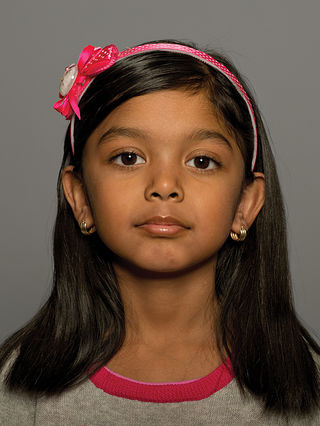Why Some Children Are Orchids and Others Are Dandelions
Many children are able to thrive in any environment, while others may flourish only under the most favorable conditions. New findings reveal the complex interplay of factors that creates "dandelion" and "orchid" kids.
By W. Thomas Boyce M.D. published January 2, 2019 - last reviewed on April 11, 2019
One of the first skills taught to pediatricians and obstetricians is how to assess the physiological condition of a baby in the first few minutes after birth. As a novice physician, this was one of my favorite and most treasured duties—to be the first living soul to survey the condition of a never-before-seen human being, delivered red, squealing, and literally wet behind the ears at the end of a prolonged, critical, and one-way passage.
The formal assessment is done using the Apgar score, named for its inventor, Virginia Apgar, at one and five minutes following birth. Scores range from 0 to 10, the sum of a 0, 1, or 2 assessed in each of five areas of postnatal functioning, arranged into the acronym APGAR: Appearance (the pink or blue color of the body, hands, and feet); Pulse rate; Grimace (the crying or grimacing response to nasal or oral suction, or other stimulation); Activity (the degree and vigor of muscle flexion); and Respiration. Most babies receive scores ranging from 7 to 10. Those with scores below 7 may need more active and rapid stimulation or resuscitation, including a heated bassinet or a suctioning of the airway. For scores less than 4, we might insert a breathing tube to support respiration or even begin external heart compressions.
HOW DO KIDS COPE? To get a sense of how school-age children think about resilience, PT asked a few how they cheer up others or whether they have a go-to strategy for themselves. Their portraits follow.

Orchids and Dandelions
As a pediatrician for more than four decades, I have become vividly aware of the great unevenness—the disproportion—evident in the differences in health and development among individual children from the first moments of life. Even within single families, parents often tell me that all of their children were basically healthy, "except for Sarah," or Julio, or Jamal. Pediatricians implicitly understand, from simple, day-to-day observation, that some children are inordinately affected by the forces that protect health and those that imperil it. And at the level of the community, we know that, within any given population of children, a small minority—about 20 percent of individuals—will suffer the majority of all illnesses and disorders.
Developmental science has convincingly shown that one of the origins of such differences is children's early experiences of psychological trauma and adversity. Such experience can impede normal brain development, create obstacles to effective learning, and impair mental and physical health during childhood and over the remaining life course. This is why children growing up in poverty, children who are mistreated by their parents or others, and children exposed to violence within the family or community are all at risk for compromised development, educational achievement, and mental or physical health.
But all children are not equally susceptible to these effects. While some are powerfully affected by trauma, others are able to effectively weather adverse experiences, sustaining few, if any, developmental or health consequences. People tend to view these differences in susceptibility as attributable to an inherent vulnerability or resilience, imagining that some small number of resilient or "unbreakable" children have a special capacity to thrive, even in the face of severe adversity. Our research suggests instead that such variance is attributable not to innate traits but to differences in children's relative biological susceptibility to the social contexts in which they live and grow, both the negative and the positive.
A majority of children show a kind of biological indifference to experiences of adversity, with stress response circuits in their brains that are minimally reactive to such events. Like dandelions that thrive in almost any environment, such children are mostly unperturbed by the stressors and traumas they confront. We think of them, metaphorically, as dandelion children. A minority of children—about one in five—show an exceptional susceptibility to both negative and positive social contexts, with stress response circuits highly sensitive to adverse events. Like orchids, which require very particular, supportive environments to thrive, these children show an exceptional capacity for succeeding in nurturant, supportive circumstances, but sustain disproportionate numbers of illnesses and problems when raised in stressful, adverse social conditions. We think of these as orchid children.

Developmental science is increasingly revealing that the relative indifference of dandelion children and the special sensitivity of orchid children to the character of their early environment are likely attributable to the joint effects of genes and social contexts. These epigenetic processes—in which environmental cues regulate the expression of genetic differences—are the likely regulators of children's differential susceptibility to environmental influences. Recognizing this differential susceptibility is an essential key to understanding the experiences of individual children, to parenting children of differing sensitivities and temperaments effectively, and to fostering the healthy, adaptive capacity of all young people.
Origins of the Types
So, are orchids born that way, or do they become orchids by way of early life experience? Our first hint at an answer came from the very first moments of postnatal life.
What is especially interesting about the Apgar score is the degree to which the things it measures are controlled by the fight-or-flight autonomic nervous system involved in dealing with stress. Each subscore is an indicator of the body's adaptation to the considerable physical (and possibly emotional) stressors of being born; low scores are a reflection of insufficiently adaptive responses. After all, birth is an extreme and unprecedented experience, and it is such experiences that tell us most about who we are as extensions of our individual biology.
Given that we all begin life by being plunged into an epic stress reactivity experiment, might we not wonder whether the Apgar score could tell us more than just whether we need to have our mouths suctioned or our bodies warmed? If lower scores were reflective of less adaptive, less compensatory fight-or-flight responses, might they also be telling us about a baby's longer-term proclivity toward maladaptive responses to stress? Could our first extrauterine moments augur something important about our whole life yet to come?
That is exactly what we have found. Careful epidemiologic work by one of my doctoral students and a former postdoctoral fellow has found that in nearly 34,000 children from Manitoba, Canada, five-minute Apgar scores were predictive of teacher-reported developmental vulnerability at age 5 for a variety of developmental dimensions. For example, the teachers of children who had Apgar scores of 7 identified more areas of developmental vulnerability than they did for children with Apgar scores of 9 or 10, and kindergartners who had Apgar scores of 3 or 4 had more reported developmental vulnerabilities than did peers with scores of 6 or 7. (The teachers had no prior knowledge of their students' Apgar scores.) The vulnerabilities that teachers reported might have included lower competence in following rules or instructions; an inability to sit still and focus; a relative lack of interest in books and reading; or an inability to properly grasp and use a pencil. At each lower step on the Apgar scale, such physical, social, emotional, language, and communication domains of development were all significantly more compromised five years later. Babies entering the world with greater fight-or-flight instability and less capacity for physiological recovery were more developmentally vulnerable.

Nature vs. Nurture
One source of such variation in adaptive stability is surely genetic difference among infants, but genes alone do not make a child an orchid or a dandelion. As work by other researchers has shown, the genetic characteristics of children create their predispositions, but do not necessarily determine their outcomes.
For example, a consortium studying Romanian children raised in horribly negligent, sometimes cruel orphanages under the dictatorship of Nicolae Ceauşescu, before his fall in 1989, discovered that a shorter version of a gene related to the neurotransmitter serotonin produced orchid-like outcomes. Children with this shorter allele (an alternative form of a gene) who remained in the orphanages developed intellectual impairments and extreme maladjustment, while those with the same allele who were adopted into foster families recovered remarkably, in terms of both development and mental health.
Similarly, a team of Dutch researchers studying experimental patterns of children's financial donations—in response to an emotionally evocative UNICEF video—found that participants with an orchid-like dopamine neurotransmitter gene gave either the most charitable contributions or the least, depending upon whether they were rated securely or insecurely attached to their parents—that is, depending on factors that were not genetic.
We used to think that any trait or feature present at birth was "congenital" and therefore determined by genes or, in ancient terms, fated in the stars. A somewhat more contemporary version of this vision is known as genetic determinism, according to which all of our differences are firmly situated at conception in the merged DNA we inherit from our parents. We can think of this view as the "nature" side of the classic debate of nature versus nurture.

The Human Genome Project—the ultimate "nature" approach—promised to uncover the "genes for" autism, schizophrenia, heart disease, and cancer. But no such unitary genes or even sets of genes have been elucidated. It is now clear that who we become is not determined by a straightforward, one-to-one route from genes to behavior, or DNA to phenotype—the set of observable characteristics, such as eye color, personality, and behavior, that describe an individual. Our most vaunted, prized, and carefully articulated hypotheses pale in the face of the exquisite complexities of the natural world.
There's an old pediatric adage that all parents-to-be are environmental determinists until they have a baby in hand, at which point they become genetic determinists. Here is what I mean: Before we have kids, we're prone to seeing the misbehavior of a child as the product of flawed parenting. That kid throwing a tantrum at the table next to us in a restaurant? It's obviously the parents' fault for not controlling him—their nurture hasn't accomplished what it needed to do. Once we're responsible for our own felon-in-training, throwing the tantrum in the adjacent airplane seat, we hope that those around us understand that we've done our best, but the child came into the world with this temperament. It's far more comforting to ascribe the behavior of our own noisy or troubling toddler to genes, for which we have only passive responsibility, than to our capacities as parents, for which we are more directly accountable.
In his book Either/Or, Søren Kierkegaard proposed that to fully understand the human condition, we need to dispense with the tendency to perceive the forces that form us as clear-cut dichotomies. Such binary views run counter to the complexities of our true character. Developmental science has in recent decades faced an "either/or" divide: The environmental view has demanded an allegiance to external causes, located within our social and physical contexts, and the genetic view has asserted that internal causes are preeminent, with genomes driving our phenotypes and lives. The positions have emerged as contradictory answers to the fundamental questions, "Why do some get sick and others do not?" and "Why are some so healthy and fulfilled while others are not?" We now know that it is almost never a matter of either/or, but rather both/and.

Unpuzzling Human Disposition
Every human disposition and disorder of mental or physical health depends on an intricate interaction between internal and external causes to take root and advance. The key to understanding human difference and to abating and preventing morbidity will involve a keener knowledge of how genetic difference and environmental variation work together to change biological processes. This approach to "unpuzzling" human nature and wellness brings us closer to understanding what makes orchids and dandelions bloom, wither, or move between these states over the course of a changing life. Both genes and social environments are almost certainly influential for both orchid and dandelion phenotypes, but it is likely the interaction of genes and environments that determine where the kids in my studies ended up on the graphs that we created to chart their behavior and health.
Human infants, even prior to birth, are remarkably and finely attuned to the dynamic features of their environment, first in the womb and later in the nest with which their parents surround them. The brain of the human fetus and newborn is a "black hole" of sensory capacity that can respond to its environment even before consciousness registers it. A newborn unconsciously adapts in the service of "early life programming," as biological adjustments begin, without awareness, as soon as the brain begins to detect challenges. This early programming enhances the likelihood of short-term survival—at least until the capacity for reproducing comes online in puberty, but it may also have the downside of generating greater risks of chronic adult conditions, such as coronary heart disease, obesity, diabetes, and mental disorders. It is an evolutionary strategy of trading survival in the short run for diminished and less vigorous longevity.
We think that differential susceptibilities to the environment—and thus orchid and dandelion children—emerge in this way. In certain kinds of early social and physical contexts, important benefits to survival and thriving might accrue for children with special, enhanced sensitivities. Children reared in environments of continuous threat and predation, for example, might logically be protected by the vigilance and hawk-eyed attentiveness of orchid sensibilities. Millennia ago, having a few orchidish individuals within a hominid band might have been protective of the group, as attacks from animals and other groups arose. On the other hand, being an orchid might also be of great benefit to those living at the other extreme—in environments of exceptional safety, protection, and abundance. Here, the propensity of orchid children to be open and porous to environmental events and exposures would garner even greater advantages. Most children would thrive in such settings. Orchids would thrive spectacularly.
Outside of these most extreme conditions, however, being a dandelion must surely yield the greatest rewards at the smallest price. Dandelions seem impervious to all but the most virulent of threats and insults. Within the typical ups and downs of human societies, these are the individuals deemed resilient, hardy, and buoyant. Evolution should thus tend to favor a proliferation of orchid phenotypes at the extremes of environmental conditions, while dandelion phenotypes should predominate within the broad middle range of challenges. Sure enough, there is at least preliminary evidence that dandelions are disproportionately represented in settings where neither menaces nor great fortune predominate.

Marking Our Genes
During a formative, seven-year sojourn in the frigid green wilds of Canada, at the University of British Columbia, I had the good fortune to meet Mike Kobor and Marla Sokolowski. Mike studies the molecular biology of the yeast genome, and Marla is a fly geneticist who discovered the foraging gene (known as for ) in fruit flies and is responsible for the work defining two major behavioral phenotypes in flies (and other species)—"rovers" and "sitters"— determined by DNA sequence differences in that gene.
Mike and Marla share a capacity for broadly envisioning the implications of discoveries in basic animal models for human societies: They discern our civilizations in our genes. We converged under the sponsorship of the Canadian Institute for Advanced Research (CIFAR), forming the Child and Brain Development Program, which Marla and I now co-lead. Our program quickly closed in on the captivating question of how genes and environments, especially environments of adversity and inequality, together produce known individual differences in susceptibility, behavior, health, and disease. The answer has proven key to a provisional understanding of where orchids and dandelions come from.
We have established that genetic variation—differences in the DNA code that makes up individual genes—plays a role in the genesis of orchid and dandelion children. Although many genes likely contribute to the phenotypes, those involved in brain development and function are almost certainly implicated. The expression of genes involved in emotion regulation and behavioral control, for example— features that are highly salient in orchids and dandelions—govern neurotransmitter communications among individual neurons.
But early environmental experiences undoubtedly play an additional role, especially exposure to adversity and threat and experiences of family or community support and nurture. Emerging science suggests that genes and environments contribute to the emergence of orchids and dandelions, additively and interactively, but until recently we had no real idea of how this interaction actually took place. The field that has now flooded this enigmatic landscape with new light is epigenetics, the science of how environmental exposures can modify gene expression without altering the DNA sequence of the gene itself. The Greek prefix epi—meaning "upon" or "above"—connotes how the epigenome, a lattice of chemical "marks" or tags, literally lies upon the genome and controls the expression or silencing of DNA.

Every type of cell we possess—blood, liver, lung, skin, brain—contains precisely the same genome, the same collection of genes with the same DNA sequences, half from our mothers and half from our fathers. The only way that the 200 or so different human cell types, each with a different structure and different functions, could be made from a single genome is if the functioning of our 25,000 genes could be independently controlled. That's how the epigenome comes into play in embryonic development. Stem cells can become kidney cells or white blood cells only through the programmed, epigenetic regulation of those thousands of genes. Once a stem cell is differentiated—say, into a white blood cell—the functioning of that cell can also be adjusted (again, epigenetically) to accommodate or adapt to the conditions with which the cell or the whole organism is contending. For example, a child facing a seriously stressful environment might need to change white blood cells' rate of division (increasing the number of available immune cells), the cells' responsiveness to stress hormones (sensitizing them to the effects of cortisol), or their production of the molecules initiating and governing inflammation (such as the chemical messengers called cytokines).
So, the epigenome has two major functions: It regulates the differentiation of cells into their various types and tissues, and it facilitates an adjustment of cell function to respond to the conditions at hand. It does both of these by regulating the epigenetic chemical tags that attach to the genome, turning up or turning down the expression of the thousands of genes in each cell. It is a great and agile improviser.
Pianos and Equalizers
Think of the genome and epigenome like this: Your genes are the keys on a piano; each plays a distinctive note. But while a piano has just 88 white and black keys, your genome houses around 25,000 individual genes, making it thousands of times more complex. In the first kind of epigenetic regulation—cell differentiation—these keys can be played in different combinations, sequences, and timings to create a whole variety of different tunes—200 different ones, for each of the different types of cells in a human body. One corresponds to the production of neurons, another to white blood cells, yet another to skin cells, and so on.
Once cells are differentiated on this magnificent piano, the epigenome is then used for a second kind of process: the adjustment of cell function to the conditions the organism is encountering. Here, the epigenome serves as an "equalizer" that adjusts each cell's functions, changing the way its tune sounds, like the levers on an audio equalizer adjusting the balance between sound frequency ranges to emphasize treble or bass notes. Although each type of cell always plays the same tune—a white blood cell will stay a white blood cell—the way that the cell functions can be adaptively adjusted to suit specific circumstances.

For example, the body of a child encountering a major early life stressor, like maltreatment, might automatically adjust the functioning of many different cell types in order to adapt as well as possible to the experience. Adrenal gland cells might be called upon to produce more cortisol; nerve cells could activate the fight-or-flight system; white blood cells could respond to any physical injuries; and brain cells might dampen the child's emotional response. And these would be only four adjustments among probably hundreds occurring at the same time.
Just as biobehavioral phenotypes, like orchid and dandelion children, are likely influenced by DNA sequence variations in many genes, it is probably also true that the effects of early experience on these phenotypes involve many epigenetic changes within multiple genes. Just which genes are different in sequence and where the epigenetic marks occur is still being worked out, for orchid versus dandelion, introvert versus extrovert, predispositions to depression versus predilections for joy, and other human differences.
What we now know with some certainty, however, is that most variation in human character, nature, and health will eventually be attributable to an interactive combination of differences in the DNA sequences of multiple genes, along with experience-driven differences in the epigenetic marks that shape the expression, or decoding, of multiple genes. What is wickedly complex in the number of variations involved is elegantly simple in design: Genes and experience interactively affect human destiny, and the epigenome is the physical link between a gene and its environment. You can think of human life as the song that issues from the epigenetic piano and its equalizer, the result of a complex compositional process shaped by both genes and environments. Each person is predisposed to play certain types of scores, like those of the orchid or the dandelion, but there is abundant space for unique variation and improvisation.

Excerpted from THE ORCHID AND THE DANDELION: Why Some Children Struggle and How All Can Thrive. Copyright © 2019 by W. Thomas Boyce, M.D. Published by Alfred A. Knopf.
Submit your response to this story to letters@psychologytoday.com. If you would like us to consider your letter for publication, please include your name, city, and state. Letters may be edited for length and clarity.
Pick up a copy of Psychology Today on newsstands now or subscribe to read the the rest of the latest issue.
Facebook Image: Yuliia D/Shutterstock
LinkedIn Image: Lopolo/Shutterstock
